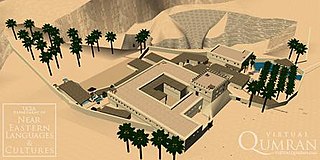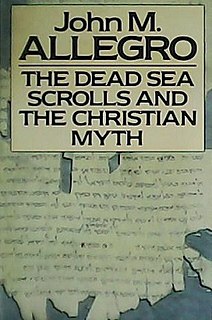The Essenes were a mystic Jewish sect during the Second Temple period that flourished from the 2nd century BCE to the 1st century CE.

The Dead Sea Scrolls are ancient Jewish and Hebrew religious manuscripts discovered in 1946/7 at the Qumran Caves in what was then Mandatory Palestine, near Ein Feshkha in the West Bank, on the northern shore of the Dead Sea. Dating from the 3rd century BCE to the 1st century CE, the Dead Sea Scrolls are considered to be a keystone in the history of archaeology with great historical, religious, and linguistic significance because they include the oldest surviving manuscripts of entire books later included in the biblical canons, along with deuterocanonical and extra-biblical manuscripts which preserve evidence of the diversity of religious thought in late Second Temple Judaism. At the same time they cast new light on the emergence of Christianity and of Rabbinic Judaism. Most of the scrolls are held by Israel in the Shrine of the Book at the Israel Museum, but their ownership is disputed by Jordan due to the Qumran Caves' history: following the End of the British Mandate for Palestine in 1947, Jordan occupied the area in the 1948 Arab-Israeli War, and Israel captured both it and several Scrolls claimed by Jordan in the 1967 Six Day War. As a result, some of the scrolls are still in Jordan and are now displayed at The Jordan Museum in Amman. Ownership of the scrolls is also contested by the State of Palestine.

Qumran is an archaeological site in the West Bank managed by Israel's Qumran National Park. It is located on a dry marl plateau about 1.5 km (1 mi) from the northwestern shore of the Dead Sea, near the Israeli settlement and kibbutz of Kalya.

Pesher, from the Hebrew root meaning "interpretation," is a group of interpretive commentaries on scripture. The pesharim commentaries became known from the discovery of the Dead Sea Scrolls. The pesharim give a theory of scriptural interpretation of a number of biblical texts from the Hebrew Bible, such as Habakkuk and Psalms.

John Marco Allegro was an English archaeologist and Dead Sea Scrolls scholar. He was a populariser of the Dead Sea Scrolls through his books and radio broadcasts. He was the editor of some of the most famous and controversial scrolls published, the pesharim. A number of Allegro's later books, including The Sacred Mushroom and the Cross, brought him both popular fame and notoriety, and also complicated his career.

Roland Guérin de Vaux was a French Dominican priest who led the Catholic team that initially worked on the Dead Sea Scrolls. He was the director of the Ecole Biblique, a French Catholic Theological School in East Jerusalem, and he was charged with overseeing research on the scrolls. His team excavated the ancient site of Khirbet Qumran (1951–1956) as well as several caves near Qumran northwest of the Dead Sea. The excavations were led by Ibrahim El-Assouli, caretaker of the Palestine Archaeological Museum, or what came to be known as the Rockefeller Museum in Jerusalem.

Robert Eisenman is an American biblical scholar, historian, archaeologist, and poet. He is currently professor of Middle East religions, archaeology, and Islamic law and director of the Institute for the Study of Judaeo-Christian Origins at California State University Long Beach.

The Dead Sea Scrolls Deception is a book by authors Michael Baigent and Richard Leigh. Rejecting the established scholarly consensus that the Dead Sea scrolls were the work of a marginal Jewish apocalyptic movement, and following primarily the thesis of Robert Eisenman, the authors argue that the scrolls were the work of Jewish zealots who had much in common with, and may have been identical to, the early followers of Jesus led by his brother James the Just. Their unconventional hypothesis provides a different version of the history of early Christianity and challenges the divinity of Jesus.
The Teacher of Righteousness is a figure found in some of the Dead Sea Scrolls at Qumran, most prominently in the Damascus Document. This document speaks briefly of the origins of the sect, probably Essenes, 390 years after the reign of Nebuchadnezzar and after 20 years of "groping" blindly for the way. "God... raised for them a Teacher of Righteousness to guide them in the way of His heart".
The Community Rule, which is designated 1QS and was previously referred to as the Manual of Discipline, is one of the first scrolls to be discovered near khirbet Qumran, the scrolls found in the eleven caves between 1947 and 1954 are now referred to simply as the Dead Sea Scrolls. The Rule of the Community is a key sectarian document and is seen as definitive for classifying other compositions as sectarian or non-sectarian. Among the nearly 350 documents discovered, roughly 30% of the scrolls are classified as "sectarian".

Ancient Qumran: A Virtual Reality Tour is the title of a computer-generated film that presents a theoretical reconstruction of the ancient Khirbet Qumran site in the West Bank. The film is silent, but is projected together with an oral presentation interpreting the Qumran site's historical significance. The film and presentation were authored by Robert Cargill, while a graduate student at UCLA and an associate of the Qumran Visualization Project (QVP) directed by UCLA bible scholar William Schniedewind. QVP presents itself as "a tool to better illustrate the daily life of the community described within the [Dead Sea] scrolls." The UCLA International Institute, cites Cargill and Schniedewind as saying that their new virtual model resolves long-simmering controversies surrounding the important Dead Sea Scrolls site.

Who Wrote the Dead Sea Scrolls? The Search for the Secret Of Qumran is a book by Norman Golb which intensifies the debate over the origins of the Dead Sea Scrolls, furthering the opinion that the scrolls were not the work of the Essenes, as other scholars claim, but written in Jerusalem and moved to Qumran in anticipation of the Roman siege in 70 AD.

Qumran Caves are a series of caves, both natural and artificial, found around the archaeological site of Qumran in the Judaean Desert. It is in these caves that the Dead Sea Scrolls were discovered.
Hartmut Stegemann was a German theologian with an interest in the New Testament and who specialized in Dead Sea Scrolls research. He was responsible for developing standard methods for reconstructing scrolls.

Wadi Murabba'at, also known as Nahal Darga, is a ravine cut by a seasonal stream which runs from the Judean desert east of Bethlehem past the Herodium down to the Dead Sea 18 km south of Khirbet Qumran in the West Bank. It was here in caves that Jewish fighters hid out during the Bar Kochba revolt, leaving behind documents that include some letters signed by Simon Bar Kochba.
The Nahum Commentary or Pesher Nahum, labelled 4QpNah or 4Q169, was among the Dead Sea Scrolls in cave 4 of Qumran that was discovered in August 1952. The editio princeps of the text is to be found in DJD V., edited by John Allegro. The text is described thus: 'one of the "continuous pesharim" from Qumran, successive verses from the biblical Book of Nahum are interpreted as reflecting historical realities of the 1st century BCE."

The Sacred Mushroom and the Cross: A Study of the Nature and Origins of Christianity Within the Fertility Cults of the Ancient Near East is a 1970 book about the linguistics of early Christianity and fertility cults in the Ancient Near East. It was written by John Marco Allegro (1923–1988).

The Dead Sea Scrolls and the Christian myth is a 1979 book about the Dead Sea Scrolls, Essenes and early Christianity that proposes the non-existence of Jesus Christ. It was written by John Marco Allegro (1922–1988).

4Q166, also known as The Hosea Commentary Scroll, is one of the Dead Sea Scrolls and was found in Cave 4 at Qumran in the West Bank. The parchment of 4Q166, 17.5 cm by 16.8 cm in size, is estimated from late first century B.C.E. The manuscript is the larger of two unrelated fragments of the Hosea Commentary found in Cave 4. The script, which is identical to that of a commentary on Psalms, belongs to the rustic, semiformal type of the Herodian era.














